AUTO LOCKING HUB NOISE OPERATION MANUAL REVISION

The following bulletin includes a revised "General Description". This general description should be referenced when needed. Disregard the general description on page 3C-27 of the 1981 and 1982 Light Duty Truck Service Manual. This bulletin also includes "Lubrication Information" and a brief statement of a particular mode of operation which when understood can be helpful during diagnosis.
GENERAL DESCRIPTION
The automatic locking hub, shown in the attached figure engages or disengages to lock the front axle shaft to the hub of the front wheel. Engagement occurs whenever the vehicle is operated in four-wheel drive. Disengagement occurs whenever two-wheel drive has been selected and the vehicle's direction is reversed. The outer clutch housing is splined to the wheel. The hub sleeve is splined to the front axle shaft. The clutch gear is splined to the hub sleeve. Engagement occurs when the clutch gear is moved on the splines of the hub sleeve to engage the internal teeth of the outer clutch housing.
The cam surface of the steel inner cage forces the cam follower and clutch gear to move outward toward the cover and into engagement with the clutch teeth of the outer clutch housing. A lug on the inside of the drag sleeve retainer washer keys the washer to the spindle and two lock nuts retain this washer in position. Cutouts in the drag sleeve engage the four tabs on the drag sleeve retainer washer to hold the drag sleeve in a fixed position with respect to the spindle. The one way clutch spring (called a brake band) is positioned over the serrated portion of the drag sleeve.
Engagement is accomplished (when four-wheel drive is selected) by the movement of the axle shaft, causing one of the tangs of the brake band to engage the steel outer cage and rotate the cage which will cause the cam ramp to move the clutch gear into mesh with the outer clutch housing. One of the tangs of the brake band is used for engagement. The other tang is used to maintain free motion of the brake band relative to the drag sleeve during fourwheel drive operation (after the hub lock engages).
Disengagement is accomplished (when two-wheel drive has been selected) by the reverse movement of the wheel causing the clutch gear, hub sleeve, and cam follower to rotate. The cam follower moves away from the lugs of the plastic outer cage, allowing the cage to rotate and the cam follower to move to the disengaged condition. The release spring then moves the clutch gear out of mesh with the outer clutch housing to disengage the wheel from the axle shaft.
LUBE INFORMATION
The following listed lubricant or an equivalent, must be used if needed.
LOCATION LUBE
*BRAKE BAND AND DRAG SLEEVE ....... P/N 1052750
HUB BALL BEARING NOT VEHICLE .... P/N 1052750/or Wheel WHEEL BEARING Bearing Lube P/N 1051344
ALL OTHER AUTOMATIC HUB ......... DEXTRON II COMPONENTS (A light film is sufficient)
*Only necessary if these parts are being reused. New parts come pre-lubed.
A MODE OF OPERATION
If for any reason there is a partial transfer case engagement, it is possible to have sufficient drive through the hypoid pinion of the front axle assembly for one automatic hub to engage (and possibly both). If only one hub is engaged and no continuous drive is being provided through the hypoid pinion, then the engaged hub will motor that axle shaft in the same direction as the vehicle is being driven. This motoring of one axle shaft will (through the differential side gears and pinions) result in the opposite axle shaft motoring in the opposite direction that the vehicle is being driven. With continued operation in this mode, the unlocked hub can be damaged. A ratcheting or clicking noise above 15 mph should warn the vehicle operator. The sunvisor decal explains what should be done if this noise is heard.

General Motors bulletins are intended for use by professional technicians, not a "do-it-yourselfer". They are written to inform those technicians of conditions that may occur on some vehicles, or to provide information that could assist in the proper service of a vehicle. Properly trained technicians have the equipment, tools, safety instructions and know-how to do a job properly and safely. If a condition is described, do not assume that the bulletin applies to your vehicle, or that your vehicle will have that condition. See a General Motors dealer servicing your brand of General Motors vehicle for information on whether your vehicle may benefit from the information.
